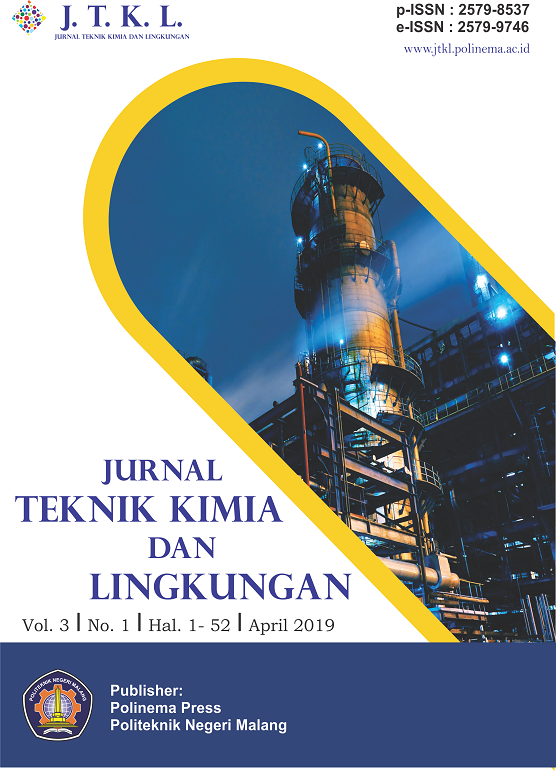Pengaruh Pitch Turbulator Terhadap NTU Pada Double Pipe Heat Exchanger
DOI:
https://doi.org/10.33795/jtkl.v3i1.101%20Keywords:
heat exhanger, helical turbulator, NTU, pitchAbstract
Saat ini kebutuhan akan energi di dunia terus meningkat, sejalan dengan semakin tumbuhnya industri untuk menopang kehidupan manusia. Namun kenaikan kebutuhan energi tersebut tidak diimbangi dengan bertambahnya sumber energi, sehingga harga energi semakin mahal. Untuk meminimalisir kebutuhan energi, maka perlu dicari sumber-sumber energi alternatif baru, terutama sumber energi baru dan terbarukan. Disamping itu perlu dilakukan pengelolaan energi yang lebih baik, sehingga kebutuhan energi dunia bisa dikurangi. Double Pipe Heat exchanger memiliki pipa luar stainless steel dengan diameter dalam (Do) 3,5 inchi, ketebalan pipa (To) 1,5 mm, dan panjang pipa (Lo) 790mm dan pipa dalam (Di) 1 3/8 inchi, ketebalan(Ti) 0,6 mm, dan panjang pipa (Li) 920mm, dengan air dingin dan air panas yang digunakan sebagai fluida uji di annulus dan pipa dalam. Helical turbulator dari besi (mild steel) dengan dimensi geometris jarak antar elemen (pitch) sebesar 25mm, 50 mm dan 75 mm berdiameter dalam (Di) 5/16 inchi dan diameter luar(Do) 1 5/16 inchi dengan panjang 750mm dimasukkan dalam inner tube dari heat exchanger. Air panas memasuki tabung dengan variasi flowate mulai 400 l/jam sampai 900 l/jam, sedangkan flowrate air dingin konstan 900 l/jam. Hasil penelitian dengan disisipkannya helical turbulator sebagai turbulator pada heat exchanger mengakibatkan peningkatan laju perpindahan kalor. Helical turbulator dengan pitch 25mm menimbulkan peningkatan laju perpindahan kalor paling besar sebesar 62% dibandingkan plain tube. Helical turbulator mengakibatkan peningkatan NTU heat exchanger terbesar sebesar 63% dihasilkan oleh helical turbulator dengan pitch 25mm.
At present the need for energy in the world continues to increase, in line with the growing industry to sustain human life. However, the increase in energy needs is not offset by the increase in energy sources, so energy prices are increasingly expensive. To minimize energy needs, it is necessary to look for new alternative energy sources, especially new and renewable energy sources. Besides that, better energy management is needed, so that the world's energy needs can be reduced. Double Pipe Heat Exchanger has stainless steel outer pipe with inner diameter (Do) 3.5 inch, pipe thickness (To) 1.5 mm, and pipe length (Lo) 790 mm and pipe inside (Di) 1 3/8 inch, thickness (Ti) 0.6 mm, and the length of pipe (Li) 920 mm, with cold water and hot water used as test fluid in the annulus and inner pipe. Mild steel helical turbulators with geometric dimensions of 25mm, 50mm and 75mm intervals between 5/16 inch in diameter and a 750mm length 5/16 inch outer diameter (Do) are included in the inner tube of heat exchanger. Hot water enters the tube with variations in flowate from 400 l / hour to 900 l / hour, while the cold water flowrate is constant 900 l / hour. The results of the study by inserting a helical turbulator as a turbulator in a heat exchanger resulted in an increase in the heat transfer rate. Helical turbulators with a pitch of 25mm give rise to the highest heat transfer rate of ±62% compared to plain tubes. Helical turbulators cause the largest increase in NTU heat exchanger of ±63% produced by a helical turbulator with a 25mm pitch.
References
M. A. J. Selvam, S. Kumar P, S. Muthuraman, The characteristics of brazed plate heat exchangers with different chevron angles, Asian Res. Publ. Netw., vol. 4, no. 10, hal. 19- 26, 2009.
A. E. Bergles, The Imperative to Enhance Heat Transfer, in: Energy Conservation through Heat Transfer Enhancement of Heat Exchanger, NATO Advanced Study Institute, Izmir-Turkey, 1998.
Y. A. Çengel, Heat Transfer A Practical Approach, 2nd edition, New York, Mc Graw Hill Companies Inc, 2003.
S. Eiamsa-ard, P. Promvonge, Heat transfer characteristics in a tube fitted with helical screw-tape with/without core-rod insert, Int. Commun. Heat Mass, vol. 34, hal. 176-185, 2006.
S. Eiamsa-ard, P. Promvonge, C. Thiaanpong, S. Pethkool,. Turbulent flow heat transfer and pressure loss in a double pipe heat exchanger with louvered strip insert, Int. Commun. Heat Mass, no. 35, hal. 120-129, 2008.
C. J. Geankoplis, Transport Processes and Separation Process Principle, 4th edition Pearson Professional Education, 2003.
J. Gaurav, V. Hasda, Experimental Studies On Heat Transfer Augmenatation Using Modified Reduced Width Twisted Tapes (RWTT) As Inserts For Tube Side Flow of Liquids, Thesis, Department of Chemical Engineering National Institute of Technology Rourkela, 2010.
R. Kalaivanan, R. Rathnasamy, Experimental investigation of forced convective heat transfer in rectangular micro-channels, J. Eng. Appl. Sci., vol 5, no. 5, hal. 21 – 26, 2010.
P. Murugesan, K. Mayilsamy, S. Suresh, P.S.S. Srinivasan, Heat transfer and pressure drop characteristics of turbulent flow in a tube fitted with trapezoidal-cut twisted tape insert, Int. J. Acad. Res., vol. 1, no. 1, hal. 123-128, 2009.
N. S. Sarada, A.V. S. R. Raju, K. A. Radha, Experimental numerical analysis enhancement of heat transfer in a horizontal circular tube using mesh inserts in turbulent region, European Journal of Mechanical and Environmental Engineering, vol. 2, hal. 3 – 16, 2010.
N. Sahiti, F. Durst, A. Dewan, Heat transfer enhancement by pin element, Int. J. Heat Mass Trans., no. 48, hal. 4738-4747, 2005.
M. Thirumarimurugan, T. Kannadasan, E. Ramasany, Simulation studies on a cross flow plate turbulator heat exchanger, Am.
J. Appl. Sci., vol. 5, no. 10, hal. 1318- 1321, 2008.
Downloads
Published
Issue
Section
License
Copyright (c) 2019 Mufid Mufid, Arif Rahman Hakim, Bambang Widiono

This work is licensed under a Creative Commons Attribution-NonCommercial 4.0 International License.







